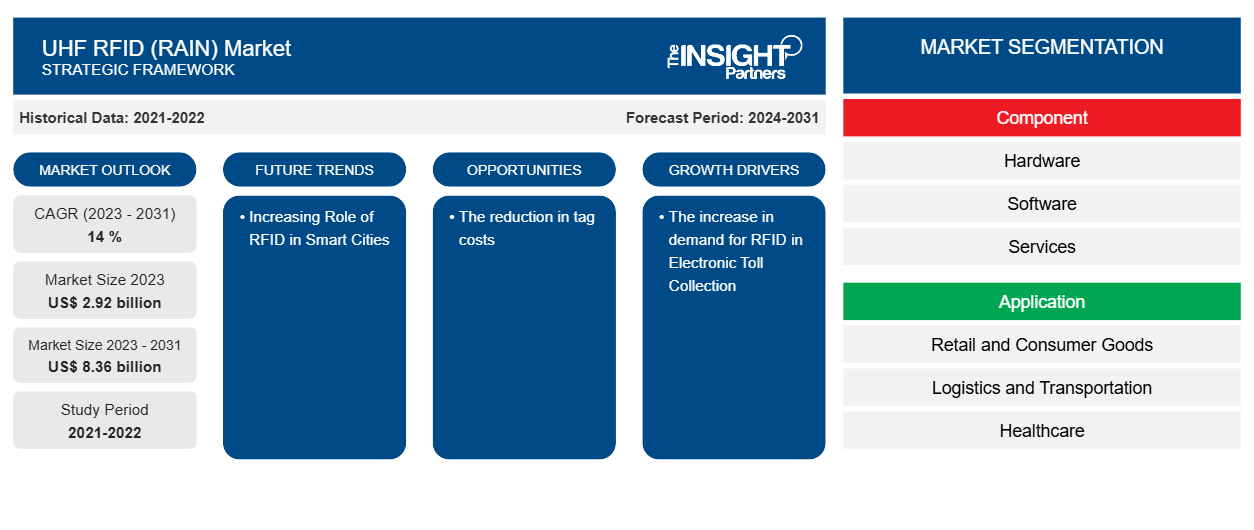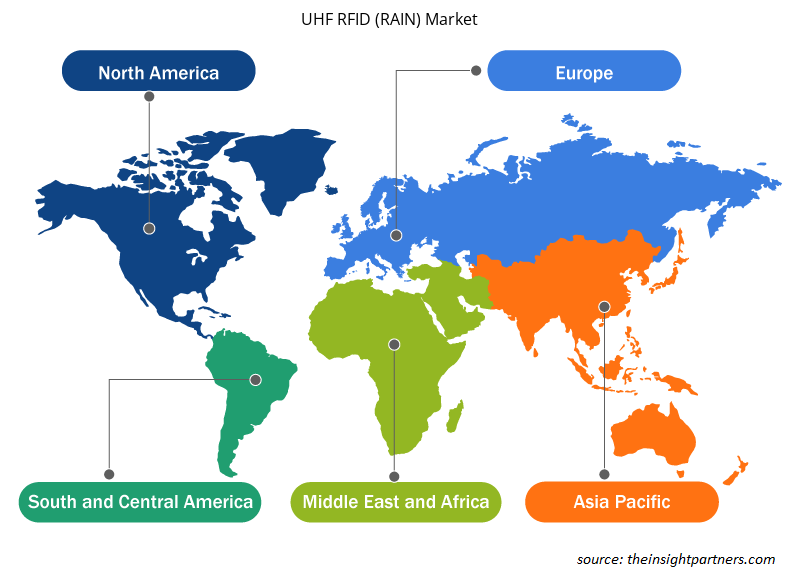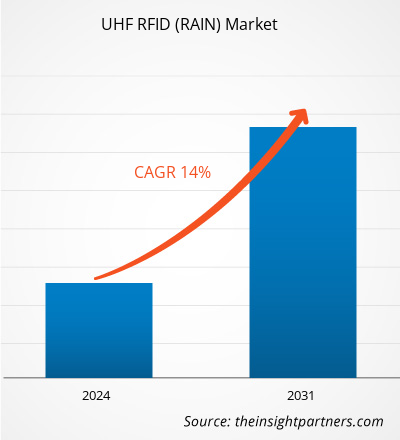UHF RFID(RAIN)市場規模は、2024年の46億2,000万米ドルから2031年には140億7,000万米ドルに達すると予測されています。市場は2025年から2031年にかけて年平均成長率(CAGR)17.9%を記録すると予想されています。自動車業界における採用の増加は、今後数年間で市場に新たなトレンドをもたらす可能性が高いでしょう。
UHF RFID(RAIN)市場分析
RAIN(UHF RFID)は、組織や消費者が日常的に使用する製品をインターネットに接続することで、識別、位置特定、検証、操作を可能にする無線技術です。RAINスペクトルは、RFID技術の超高周波帯域の上限帯域(860~960 MHz)に位置し、特定の規格やプロトコルに準拠しています。RAIN RFIDは、超高周波(UHF)で動作するパッシブ型でバッテリー不要の技術であり、最大15メートル離れた場所からでも物体を識別できます。直接視線が通っていない場合でも、1秒あたり最大1,000個の物体を認識できます。RAIN技術は、データの管理、アクションの実行、そしてリーダーを介してタグ付き物体の読み取りと書き込みを行います。これらの機能により、企業や顧客はRAINタグが付いたあらゆる物体を認識、特定、検証、操作することが可能になります。RAINは、サプライチェーンの最適化、資産追跡、在庫管理などのアプリケーションに、包括的でリアルタイムなデータと洞察を提供します。
UHF RFID(RAIN)市場概要
RAIN RFIDは、市場で商品の識別、位置特定、そして認証を効果的に行うために利用されています。その入手しやすさ、手頃な価格、そして使いやすさから、他のIoT技術とは一線を画しています。可視性を高め、正確なデータを提供するRAIN RFIDの能力は、デジタル時代におけるゲームチェンジャーとなるでしょう。
要件に合わせてレポートをカスタマイズ
このレポートの一部、国レベルの分析、Excelデータパックなど、あらゆるレポートを無料でカスタマイズできます。また、スタートアップや大学向けのお得なオファーや割引もご利用いただけます。
UHF RFID(RAIN)市場:戦略的洞察

-
このレポートの主要な市場動向を入手してください。この無料サンプルには、市場動向から見積もりや予測に至るまでのデータ分析が含まれます。
UHF RFID(RAIN)市場の推進要因と機会
小売業界におけるRFID技術の導入増加
在庫追跡技術の発展と、FacebookやGoogle広告といったオンラインマーケティングツールの重視が、小売業界の成長を牽引しています。米国では、消費者がオンラインショッピングを好む成熟産業の一つです。商務省国勢調査局のデータによると、米国の小売Eコマース売上高は2024年に1兆1,926億米ドルに達し、2023年から8.1%増加する見込みです。
小売業界では、無線周波数識別(RFID)がアパレルのタグ付けに採用されています。アパレルベンダーは、RFIDアプリケーションにデジタル化とビッグデータ分析を取り入れています。RFID技術は、無線電波を利用してRFIDタグからリーダーにデータを送信し、受信データに基づいて物体を識別し、その位置の追跡を容易にします。企業は、業務効率を高め、間接費を削減できる手頃なソリューションを求めています。アクセンチュアのデータによると、北米の小売業者の93%がこれらの目標を達成するために何らかの形でRFIDを使用しています。H&M、ルルレモン、ザラ、ナイキなどの小売業界の大手企業は、在庫管理にUHF RFID技術を使用し、効率的なサプライチェーンの維持、偽造品対策、在庫切れの防止に役立てています。ウォルマートは2020年に衣料品サプライヤーに対し、製品へのRFIDラベルの貼付を義務付けました。2022年には、この義務付けが玩具、電子機器、その他の家庭用品にも拡大されました。この義務は、2023年と2024年に自動車用品からスポーツ用品まであらゆるものに拡大されました。2025年までに、ウォルマート店舗で販売される他の製品カテゴリーの大部分がこの義務の対象となると予想されています。小売業界におけるこのような取り組みの実施は、このセグメントの市場成長を牽引するでしょう。 RFID) is adopted for digitalization and Big Data analytics in RFID applications. RFID technology utilizes radio waves to transmit data from RFID tags to a reader, enabling the identification of objects based on the received data and facilitating the tracking of their locations. Organizations are seeking affordable solutions that enable them to increase operational efficiencies and reduce overhead costs. Data from Accenture shows that 93% of North American retailers are using RFID in some capacity to achieve these goals. Retail sector giants, such as H&M, Lululemon, Zara, and Nike, use UHF RFID technology for inventory management, helping them maintain an effective supply chain, combat counterfeit items, and prevent out-of-stock situations. Walmart mandated its clothing suppliers to attach RFID labels on their products in 2020. In 2022, the mandate was extended to cover toys, electronics, and other home items. The mandate expanded to cover everything from automotive supply to sporting products in 2023 and 2024. By 2025, the majority of other product categories that are sold in Walmart stores are expected to be covered by the requirement. The implementation of such initiatives in the retail sector drives the market growth in the segment.
IoTデバイスにおけるUHF RFID技術の導入
スマートデバイスの普及と、特に日本、シンガポール、中国、オーストラリアなどの国々における政府投資が、製造業、公共事業、小売業などの分野におけるモノのインターネット(IoT)の研究開発と導入に注力しており、IoTの成長を加速させています。IoTアプリケーションは、物理世界とデジタル世界間のデータ接続を必要とし、UHF RFID技術はこれらの空間を繋ぐために用いられています。IoTの急成長に伴い、ネットワーク接続されたオブジェクトの大部分は、パッシブUHF RFID技術を介してワイヤレス接続されるようになります。この技術により、パッシブオブジェクトは重要なデータを通信することができ、正確な場所と時間の詳細に基づいてオブジェクトを識別できます。この技術は、IoTエコシステムにインテリジェンスを追加し、接続されたリソース向けの新しいアプリケーションを簡素化します。
2023年7月、Impinj社はIoT導入をサポートし、企業のアイテム接続性を強化するImpinj M800シリーズRAIN RFIDタグチップをリリースしました。これらのチップは、可読性、信頼性、製造性を向上させ、接続されたアイテムの追跡と保護におけるRAIN RFIDシステムの速度、範囲、信頼性を向上させます。この統合により、企業は正確な情報に基づいた意思決定を行うことができます。RFIDタグをインターネットに接続することで、企業はアイテムの位置、使用パターン、環境条件に関するデータを収集し、予測分析に活用することができます。したがって、IoTデバイスへのUHF RFID技術の組み込みは、市場における将来の成長機会を生み出すと期待されています。
UHF RFID(RAIN)市場レポートのセグメンテーション分析
UHF RFID (RAIN) 市場分析の導出に貢献した主なセグメントは、コンポーネントとアプリケーションです。
- 世界のUHF RFID(RAIN)市場は、コンポーネントに基づいて、ハードウェア、ソフトウェア、サービスに分類されます。2024年には、ハードウェアセグメントがUHF RFID(RAIN)市場で最大のシェアを占めました。
- UHF RFID(RAIN)市場は、用途別に、小売・消費財、物流・運輸、ヘルスケア、製造、自動車、航空宇宙・防衛、その他に分類されています。2024年には、小売・商取引関連製品セグメントがUHF RFID(RAIN)市場で最大のシェアを占めました。
UHF RFID(RAIN)市場シェア分析(地域別)
UHF RFID (RAIN) 市場レポートの地理的範囲は、主に北米、アジア太平洋、ヨーロッパ、中東およびアフリカ、南米および中米の 5 つの地域に分かれています。
北米は2024年に大きな市場シェアを占めました。米国、カナダ、メキシコは北米の主要国です。連邦通信委員会(FCC)によると、この地域のRFID UHF帯域は902〜928MHzのスペクトルで動作し、リーダーはその帯域幅のほとんどで最大電力で送信します。北米では、RFID技術は小売分野で採用されており、ワイヤレススキャンシステムを使用して物体に取り付けられたタグからデータを転送します。このセットアップは主に自動識別と追跡の目的を果たします。簡単な追跡、低コスト、および効果的な在庫管理が、北米の小売分野でのこの技術の採用を推進しています。国際貿易局(ITA)によると、2022年にはカナダのeコマースユーザーは2,700万人を超え、カナダの人口の75%を占めました。この数は2025年には77.6%に増加すると予想されています。
北米で成長を続ける小売業界では、在庫を効率的に追跡するためのUHF RFID技術の需要が高まっています。そのため、企業は小売業界の高まるニーズに応えるため、この技術の開発に非常に意欲的です。 2022年5月、エイブリィ・デニソン社は、小型でコスト効率の高い方法でアイテムレベルのタグ付けを行うNFC(HF)とRAIN RFID(UHF)を組み合わせた機能を提供する、拡張可能なデュアル周波数(DF)RFIDインレイの製品ラインに2つの新製品を追加しました。新しいAD Medio Web DF EM4425とAD Web DF EM4425 V12インレイとタグは、ブランド保護、サプライチェーン管理、顧客エンゲージメント向けに設計されています。AD Medio Web DFは医薬品およびヘルスケア用途向けに開発され、AD Web DFは小売業のユースケースに重点を置いています。エイブリィ・デニソンの定評あるAD Web RAIN RFID製品ラインをベースとした両製品は、優れた性能と独自のデュアル周波数機能を兼ね備えています。 HF および UHF RFID 周波数範囲で動作し、2 つの個別の単一周波数インレイを使用する場合に比べて大幅なコスト上の利点があります。
UHF RFID(RAIN)市場の地域別分析
Insight Partnersのアナリストは、予測期間全体を通してUHF RFID(RAIN)市場に影響を与える地域的な動向と要因を詳細に解説しています。このセクションでは、北米、ヨーロッパ、アジア太平洋、中東・アフリカ、中南米におけるUHF RFID(RAIN)市場のセグメントと地域についても解説します。

- UHF RFID(RAIN)市場の地域別データを入手
UHF RFID(RAIN)市場レポートの範囲
| レポート属性 | 詳細 |
|---|---|
| 2024年の市場規模 | 46億2000万米ドル |
| 2031年までの市場規模 | 140億7000万米ドル |
| 世界のCAGR(2025年~2031年) | 17.9% |
| 履歴データ | 2021-2023 |
| 予測期間 | 2025~2031年 |
| 対象セグメント |
コンポーネント別
|
| 対象地域と国 |
北米
|
| 市場リーダーと主要企業の概要 |
|
UHF RFID(RAIN)市場のプレーヤー密度:ビジネスダイナミクスへの影響を理解する
UHF RFID(RAIN)市場は、消費者の嗜好の変化、技術の進歩、製品メリットへの認知度の向上といった要因によるエンドユーザー需要の増加に牽引され、急速に成長しています。需要の増加に伴い、企業は製品ラインナップの拡充、消費者ニーズへの対応のためのイノベーション、そして新たなトレンドの活用を進めており、これが市場の成長をさらに加速させています。
市場プレーヤー密度とは、特定の市場または業界内で事業を展開する企業または会社の分布を指します。これは、特定の市場空間における競合企業(市場プレーヤー)の数が、その市場規模または市場価値全体と比較してどれだけ多いかを示します。
UHF RFID(RAIN)市場で事業を展開している主要企業は次のとおりです。
- カーンRFID SRL
- コンバージェンス・システムズ・リミテッド
- インピンジ株式会社
- インベンゴテクノロジーPTE.LTD.
- ジャダック
- ローリーソリューションズ株式会社
免責事項:上記の企業は、特定の順序でランク付けされているわけではありません。

- UHF RFID(RAIN)市場のトップキープレーヤーの概要を入手
UHF RFID(RAIN)市場ニュースと最近の動向
UHF RFID(RAIN)市場は、主要な企業出版物、協会データ、データベースなどを含む一次調査および二次調査に基づく定性・定量データの収集によって評価されます。UHF RFID(RAIN)市場における動向のいくつかを以下に示します。
- エイブリィ・デニソンは、PET樹脂を一切使用しないインレイとタグのポートフォリオであるAD Pureシリーズの拡充を発表しました。AD Pureのインレイとタグは、革新的なアンテナ製造技術を用いて持続可能な方法で製造されています。アンテナとチップは紙に直接貼り付けられるため、100%プラスチックフリーとなっています。(出典:エイブリィ・デニソン、プレスリリース、2024年4月)
- チェックポイント・システムズは、小売業における金属・磁石の検出に重点を置き、組織犯罪対策ソリューションのポートフォリオを強化するため、アラート・システムを買収しました。(出典:チェックポイント・システムズ、プレスリリース、2023年4月)
UHF RFID(RAIN)市場レポートの対象範囲と成果物
「UHF RFID(RAIN)市場規模と予測(2021〜2031年)」レポートでは、以下の分野をカバーする市場の詳細な分析を提供しています。
- UHF RFID(RAIN)市場規模と予測(世界、地域、国レベルで)
- UHF RFID(RAIN)市場の動向、および推進要因、制約、主要な機会などの市場動向
- 詳細なPEST分析とSWOT分析
- UHF RFID(RAIN)市場分析では、主要な市場動向、世界および地域の枠組み、主要プレーヤー、規制、最近の市場動向を網羅しています。
- UHF RFID(RAIN)市場の市場集中、ヒートマップ分析、主要プレーヤー、最近の動向を網羅した業界の展望と競争分析
- 詳細な企業プロフィール
- 過去2年間の分析、基準年、CAGRによる予測(7年間)
- PEST分析とSWOT分析
- 市場規模価値/数量 - 世界、地域、国
- 業界と競争環境
- Excel データセット
最新レポート
お客様の声
購入理由
- 情報に基づいた意思決定
- 市場動向の理解
- 競合分析
- 顧客インサイト
- 市場予測
- リスク軽減
- 戦略計画
- 投資の正当性
- 新興市場の特定
- マーケティング戦略の強化
- 業務効率の向上
- 規制動向への対応






















 無料サンプルを入手 - UHF RFID(RAIN)市場
無料サンプルを入手 - UHF RFID(RAIN)市場